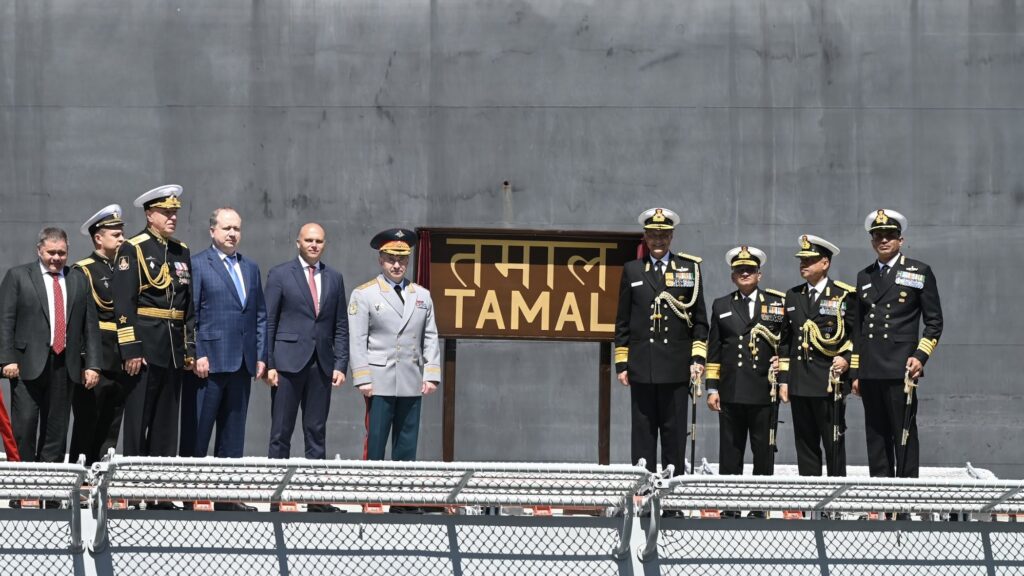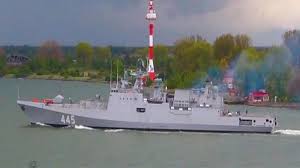
INS Tamal Warship India’s maritime strength took a significant leap forward with the induction of INS Tamal, the final foreign-built major warship sourced from Russia. As the Indian Navy progressively shifts towards indigenous warship production under the “Make in India” initiative, the arrival of INS Tamal marks both the end of an era of foreign warship procurements and the start of a new chapter in India’s defense strategy.
Let’s explore the cutting INS Tamal Warship -edge features, specifications, political context, and operational capabilities that make INS Tamal a vital asset for India’s maritime defense.
ASSAM: The Living Heritage of the Northeast
https://pagead2.googlesyndication.com/pagead/js/adsbygoogle.js?client=ca-pub-7787437288479224
Origin, Background, and Political Context of INS Tamal
INS Tamal belongs to the Project 11356M class of frigates, also known as the Admiral Grigorovich-class frigates, built by Russia’s Yantar Shipyard. These multi-role stealth frigates are part of a long-standing Indo-Russian defense collaboration.
The deal for the construction of four such frigates, including INS Tamal, was signed in 2018 during the tenure of Prime Minister Narendra Modi’s government. It was a strategic move aimed at modernizing India’s naval fleet amidst rising maritime threats in the Indian Ocean Region. The total cost of the deal was approximately USD 2.5 billion (INR 20,000 crore) for the four frigates, with two to be built in Russia and the other two in India under technology transfer agreements.
The deal also highlighted India’s balancing act in foreign policy—maintaining defense ties with Russia despite growing strategic partnerships with the United States and other Western nations.
Technical Specifications
- Ship Class: Admiral Grigorovich-class (Project 11356M)
- Displacement: Approximately 4,035 tonnes
- Length: 125 meters
- Beam: 15.2 meters
- Draft: 4.2 meters
- Speed: Up to 30 knots
- Range: 4,850 nautical miles at 14 knots cruising speed
- Crew Capacity: 180 personnel

Stealth Features and Structural Design
Tamal incorporates stealth technology to reduce radar and infrared signatures. Its angular design, radar-absorbent coatings, and hull architecture contribute to enhanced survivability in contested waters. The vessel’s optimized acoustic signature further protects it against submarine detection.
State-of-the-Art Weapon Systems
Tamal is a multi-role platform equipped with advanced weaponry capable of anti-air, anti-surface, and anti-submarine warfare. Key armaments include:
- Missiles:
- 8 x BrahMos Supersonic Cruise Missiles (surface-to-surface)
- Shtil-1 Medium-Range Surface-to-Air Missiles (MR-SAM)
- Guns:
- 1 x 100mm A-190 naval gun
- 2 x AK-630 Close-In Weapon Systems (CIWS)
- Anti-Submarine:
- Torpedo tubes
- RBU-6000 anti-submarine rocket launchers
Sensor and Combat Management Systems
Tamal boasts an advanced combat management system (CMS) that integrates its sensors and weapon systems for faster threat detection and response. Major onboard systems include:
- Fregat M2EM 3D Radar: Multi-functional surveillance radar
- MR-90 Orekh Fire Control Radar: Manages SAM engagements
- Bow-mounted and Towed Array Sonars: For sub-surface threat detection
- Electronic Warfare Suite: For signal interception and jamming capabilities
Aviation Capabilities
Tamal features a flight deck and hangar capable of supporting one Ka-31 or Ka-28 naval helicopter. These aircraft enhance the ship’s anti-submarine warfare (ASW), reconnaissance, and search and rescue capabilities.
Strategic Importance
With the induction of INS Tamal, the Indian Navy enhances its ability to safeguard national maritime interests in the Indian Ocean Region (IOR) and beyond. The frigate’s long-range cruise missiles and multi-layered defense systems enable it to conduct:
- Carrier battle group operations
- Anti-piracy patrols
- Maritime surveillance
- Disaster relief missions
- Escort duties for strategic assets
The addition of INS Tamal Warship also comes at a time when India is seeking to counter China’s growing naval presence in the Indo-Pacific. Politically, it reaffirms India’s intent to maintain a strong deterrence posture and protect critical sea lanes of communication.
Towards Naval Indigenization
Tamal represents India’s final step in acquiring major warships from foreign nations. With this addition, the Indian Navy will now focus on domestically built warships under initiatives like Project 17A and the future Destroyer and Submarine programs. This transition to indigenous shipbuilding aligns with India’s vision of becoming a self-reliant defense power and is a cornerstone of Prime Minister Modi’s “Atmanirbhar Bharat” (self-reliant India) initiative.
Conclusion
Tamal is not just another addition to the Indian Navy’s formidable fleet; it is a symbol of India’s evolving defense strategy and global naval presence. Its advanced weaponry, stealth design, and multi-role capabilities ensure that India’s maritime frontiers remain secure.
As India sails into an era of indigenous defense production, INS Tamal stands tall as a testament to decades of Indo-Russian defense cooperation and a beacon of the Indian Navy’s combat readiness. Politically, it reflects India’s strategic autonomy in global defense relations, maintaining ties with traditional partners while promoting indigenous growth.
